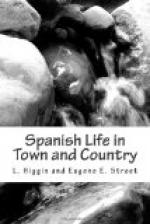Wherever two or three men and women of the lower classes are to be seen together in Spain during their play-time, there is a guitar, with singing and dancing. The verses sung are innumerable short stanzas by unknown authors; many, perhaps, improvised at the moment. The jota, the malaguena, and the seguidilla are combinations of music, song, and dance; the last two bear distinct indications of Oriental origin; each form is linked to a traditional air, with variations. The malaguena is Andalusian, and the jota is Aragonese; but both are popular in Castile. All are love-songs, most of them of great grace and beauty. Some writers complain that some of these dance-songs are coarse and more or less indecent; others aver that they never degenerate into coarseness. Quien sabe? Perhaps it is a case of Honi soit qui mal y pense. In any case, throughout the length and breadth of Spain, outside the wayside venta, or the barber’s shop, in the patios of inns, or wherever holiday-makers congregate, there is the musician twanging his guitar, there are the dancers twirling about in obvious enjoyment to the accompaniment of the stamping, clapping, and encouraging cries of the onlookers, and the graceful little verse, with its probably weird and plaintive cadence:
Era tan dichoso antes
De encontrarte en mi camino!
Y, sin embargo, no siento
El haberte conocido.
I was so happy before
I had met you on my way!
And yet there is no regret
That I have learned to know
you.
The malaguena and the seguidilla, which is more complicated, are generally seen on the stage only in Madrid, where they must charm all who can appreciate the poetry of motion. The dance of the peasant in Castile is always the jota Aragonesa. The part the tambourine and the castanets play in these dances must be seen and heard to be understood: they punctuate not only the music, but also the movement, the sentiment, and the refrain. The Andaluces excel in playing on the castanets. These are, according to Ford, the “Baetican crusmata




